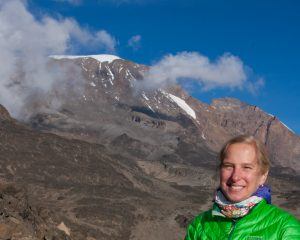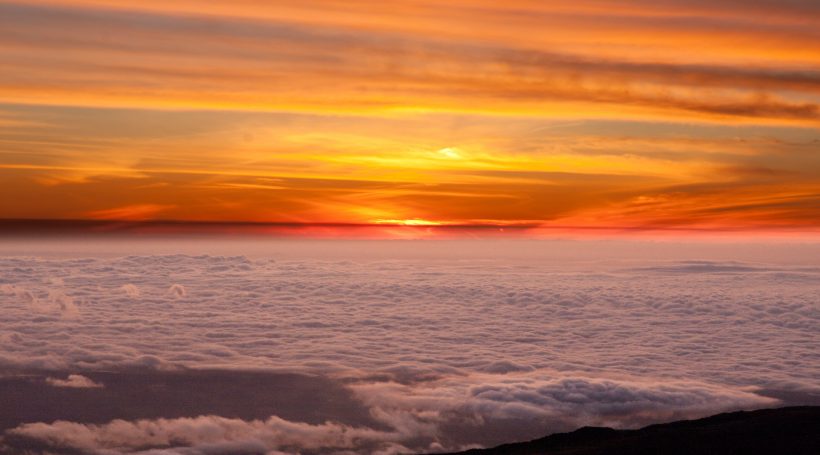It’s been her dream since the seventh grade: climb Mount Kilimanjaro, the highest mountain in Africa. Two years ago, Stephanie Farrell started thinking it just might be time to check that off her bucket list. Last August, the 48-year-old Rowan professor called some friends, put on her hiking boots and head out to conquer Kili.
“It was definitely a challenge, and I wasn’t sure how it would work out, but it worked out,” she says. “I definitely pushed my limits.”
Farrell made the climb with her husband, his sister, seven friends, one guide and two assistant guides. The trip up took six days; coming down was quicker – only two days.
“I’ve done lots of hiking, but nothing this big. This was my first extreme altitude,” Farrell says. “It’s not a technical climb. It’s really just hiking and scrambling over rocks.”
One of the biggest concerns for mountain climbers is how to acclimate the body to the changes in altitude. Many climbers experience shortness of breath, headaches and vomiting the higher they climb. Experienced hikers know slow acclimation to the altitude can help ease those symptoms.
“There’s really nothing you can do to prepare for the high altitude,” Farrell says. “You need a little bit of good luck and proper acclimatization during the climb. We chose a route that is a longer distance; I guess it’s the longest one on the mountain. But because we had more days on the mountain, the acclimatization was a lot better for us than it is for a lot of people. We had no trouble with the altitude, because we went up slowly.”

Stephanie Farrell on her ascent of Mount Kilimanjaro
Climbers can choose from six routes to climb the mountain, so Farrell spent hours researching the best one for her group. The route she chose – Alternative Lemosho – is a little off the beaten path, and known for its extraordinary scenery.
“One of the most interesting things to me was you travel in just a few days through almost every climate zone, starting with the tropical rain forest all the way up to basically an arctic desert at the top. I’ve been to rain forests, but this was different. You see giant ferns and trees, plants that are unique to Kilimanjaro – and monkeys. Then you get up to the extreme altitude where there’s no vegetation, and there are glaciers. It’s so different,” Farrell says. “Some scenery looked like Jurassic Park, some looked like a moonscape.”
Farrell was also stunned at the temperature. “Surprisingly, it’s not hot,” she says. “We thought it would be really hot because we were right at the equator, but it wasn’t. It was below 70 during the day, and it got chilly at night. As we started the climb we were in the rain forest, and we were wearing long sleeves and long pants, but no coats. Then as we went up the mountain, it got cold very quickly. It was actually the coldest place I have ever been – at the equator.”
The group hiked between four to six hours each day carrying their supplies on their backs in packs that weighed roughly 20 pounds. “We had about three liters of water in there, rain gear, sunscreen, Chapstick and layers of clothes for warmth,” Farrell says.
“I’ve traveled all over the world, but I never worried before about what I was packing. Everything we brought was a careful decision. You can’t just run out to Kmart if you need something.”
The group slept in sleeping bags and ate primarily Tanzanian and Western foods, loading up on pasta and rice, which are thought to help with acclimatization. But on the night before reaching the summit, the climbing schedule changed.
“We went to bed around 7:30 that night. We had a pretty cold summit night. It was probably around zero degrees, and it was windy. We were prepared, so we had the right clothing, but it was still really cold. We expected our water to freeze, but I didn’t know how fast it was gonna freeze. Our two hydration packs froze right away. We thought we were being smart by having thick insulation on the tubes, but it froze right away.
“We slept until about 11 and left around midnight to climb to the summit. It was really dark. We had head lamps to light what was directly in front of us,” Farrell says. “We climbed at midnight because they like to get you up there around sunrise, so you have the whole day to climb down.
“When the sun started to come up, we were at a place called Gilman’s Point, which is kind of a milestone. It’s pretty close to the summit, and there’s a big sign there that says ‘Congratulations, you have made it to Gilman’s Point.’ We took some pictures there. It was when we were taking those pictures that we noticed the sun was coming up. It was the end of a long night, and we were at this place that was a milestone, so it felt really good. From there we could see the summit, and we realized it wasn’t that far, that it was more of a hike than a climb. We could see that there was no more steep climbing, and it was a big relief. We thought we could definitely make it. It was gonna take a while, but we could make it.”
At 8 am, Farrell and her group reached the summit. “You feel like you’re on top of the world,” she says. “It’s spectacular. I remember looking at the glaciers and thinking how beautiful they were. I was happy we all got to the summit together. We were all a bit nervous before the climb. We didn’t know if we would make it, but we all did. Nobody got sick, and we all felt good. It was basically a big relief.
“I expected to feel worse at the top,” she adds. “I think I read too much about it before I went. I had read so much about how strenuous that summit night is and how awful people feel when they get to the top because of the altitude, but we didn’t feel bad at all. We felt great.”
After an hour at the top, the group began their climb down. “We climbed down for 10 hours, which seemed endless. It was harder than going up. Your legs get tired, and it’s hard on the knees. Your toes start to hurt – we all lost toenails – you’re pounding into your boots going downhill. I guess we were just more tired.”
After the climb, Farrell and her husband went on a four-day African safari. “I’m glad we did it after the climb, because we were sore and you don’t do much on a safari – you just sit there and take pictures. It was a nice way to rest up afterward.” The couple visited three parks, each offering a view of different wildlife. “When you see 200 elephants at one time, you can’t believe it. You look across the plains, and as far as you can see there are herds of zebra and gazelle, thousands of them. It’s incredible.”
Back home, the chemical engineering professor was quick to bring her Mount Kili climb into the classroom. “One of my friends on the climb is also a chemical engineer, so we had these conversations on the mountain about how we could do certain calculations using chemical engineering principles. That got me thinking that when I came back, I could incorporate some of our discussions into my class.
“As you climb Kili, you have all these different weather conditions which affect what is going on in the breathing process. I’ve incorporated that into my class on math balances,” she says. “We calculated the amount of oxygen you use on the climb and the amount of water you lose through breathing and how much you would have to drink every day to replenish that water. But the students have to keep in mind that you have to carry that water while you’re climbing. If you need to drink three liters a day just to replenish what you’re breathing, you’re carrying that.”
“I think the students find it interesting,” Farrell adds, “because we’re using real-life examples.”
Farrell hopes to have more incredible life experiences she can bring back to her students. There are many more mountains to climb, she notes, like Vinson Massif, the highest point in Antarctica and another item on her bucket list. “Climbing Kili made me want more. And what’s left? Lots.”














